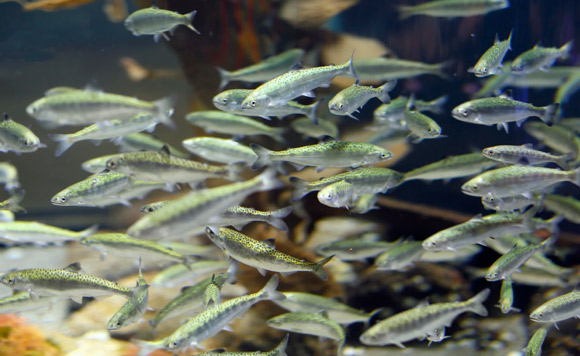by Tina Kelly, Shaw Centre for the Salish Sea –
“How many jellybeans in the jar?” is a classic game. But it’s a significantly more difficult challenge when instead of beans, what you’re trying to count is fish and they’re swimming. Standing in front of the Shaw Centre for the Salish Sea’s salmon exhibit, you’d be brave to try to guess the number of fish and lucky to get it correct. In July, the Centre received 187 salmon smolts from the Goldstream Volunteer Salmonid Enhancement Association. This large school of young fish took up residence in the Pacific salmon exhibit after the adult salmon were released into the Salish Sea.
Seventy-two adult salmon – displayed at the centre for two years – were released just a hop, skip and a jump away at Glass Beach on the Sidney waterfront. These were the last of the 200 smolts acquired in 2017; as these fish grew, small quantities were released to the sea, allowing more space for the remaining fish. This cycle of display and release has been the Centre’s salmon policy since opening in 2009.
Of the five species of Pacific salmon – pink, sockeye, coho, chum and chinook – chinook is the species on display. Although all salmon are integral to the coastal food web, chinook salmon are critical to the survival of the endangered southern resident killer whales (SKRW). An estimated 80% of their diet consists of Chinook salmon and studies consistently show there simply isn’t enough salmon to feed the SRKW population. Each SKRW needs up to 25 salmon day, equating to more than half a million fish per year. The salmon at the Centre are ambassadors for their species; providing visitors with an up close and personal look provides an opportunity to engage in conversations and educate on both salmon and their critical importance to killer whale conservation.
Releasing salmon is a complex process, requiring paperwork, policies and additional experts. A veterinarian assessment first verifies the fish are free of disease and ensures there are no issues that could affect their success in the ocean. A formal document confirming a clean bill of health is included in an application for release sent to the Department of Fisheries and Oceans (DFO). Upon agreement of release conditions – between DFO and the Centre’s Chief Aquarist – the process can continue. Among the items ticked off the pre-release day checklist are tide checks, scheduling additional staff and volunteers, and preparing the proper equipment for safe transport. The fish are carefully collected from the exhibit and heavy loads of seawater and salmon are wheeled out to the Sidney shoreline and released. Release is not the end of the process: a final batch of required paperwork must be submitted to DFO within 30 days.
In the temporary absence of fish, the exhibit receives a deep clean, making it ready to welcome the new smolts. Smolt is just one of the many phases in a salmon’s lifecycle. When a salmon hatches in a river, it becomes an alevin followed by a fry. Smolts represent the intermediary stage where the fish transition from their natal freshwater stream to the salty sea. When the smolts arrive at the Centre, transitioning them to the salt water life is an important step; over several days, the salinity of their water is increased until they are acclimatized to the salinity of the Salish Sea and their new home.
You can watch these new young silvery Chinook grow over the next two years. In 2021, it will be their turn for release. Until then, the challenge is … try to count them!
The Shaw Centre for the Salish Sea is open at 10 a.m. daily.




